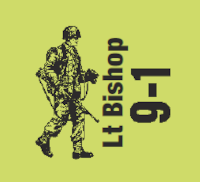
I recently took part in a discussion on attacking partially armored vehicles. The discussion took place over several days with people chiming in on their understanding. I even spoke with a friend about his thoughts. All of this discussion led me to question my understanding of the rules. People were making good points. They were hard to ignore.
I sat down to read the rules book and make sure my understanding was sound. I haven’t been this challenged to defend a point in a long time. It was an interesting exercise for me. The more I read and dug into it, the more I became confused and struggled to wade through it. The rules are not clear in this area. There was an initial Q&A response to the original topic which helped, but there was still more needed. So I reached out to Perry and asked some questions seeking clarity. Perry graciously answered quickly and I thought I’d share these insights in this article here.
What follows is my understanding of how to resolve attacks versus partially armored vehicles citing the relevant rules and Q&A.
Partially Armored
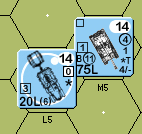
Rule D1.2 says any vehicle that has armor is an Armored Fighting Vehicle (AFV). The principal advantage of an AFV is that it is immune to Small Arms attacks, unless struck through an unarmored Target Facing/Aspect.
Per D1.22, any vehicle that has a ★ symbol beneath its side/rear Armor Factor (AF) is partially armored (i.e., armored in the front and side Target Facing and Target Aspect and unarmored in the rear Target Facing and/or Target Aspect). A “T” next to the ★ shows that only the turret or upper-superstructure Aspect of the rear Target Facing is unarmored.
Both AFV in figure 1 are partially armored. Note the ★ T for the Marder Tank Destroyer depicting an unarmored upper-superstructure. Also note the white vehicle interior on the assault gun depicting an open topped–and there unarmored aspect for all direct fire through the open top.
Target Facing and Aspect
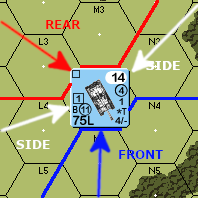
D3.2 defines Target Facing. It is the way we players decide if we strike the AFV in the front, side, or rear. The hull and turret Target Facing can be different for a turreted vehicle. Target Aspect is determined via C3.9. This is the location a vehicle actually struck in when targeted by Ordnance. A colored die less than the white die hits in the turret/upper-superstructure, otherwise we strike the hull. Each of these activities is pretty easy for most ASL players to identify. But we must make the effort not to confuse the two. Target Facing is not Aspect. This will become important here in a moment.
Figure 2 shows attacks against different Target Facings. The colored die relative to the white die will determine which Aspect in that Target Facing suffers a hit if necessary.
Hit Location
Recall that the To Hit DR is used to determine Hit Location (C3.9). Some attacks–such as a MOL, Flamethrower, or DC–do not use a To Hit DR. These attacks just roll a TK DR on the applicable TK table, except for a DC which uses a Position DR. In these cases, we follow the methodology of C3.9 but instead use the TK DR (or the Position DR) to determine the Aspect struck.1 For fully armored AFV this can help determine if a hit is against a rear Aspect when determining the Modified TK#. For a partially armored vehicle, this is key when determining if the attack is treated as one against an armored or unarmored vehicle.
Resolving Collateral Attacks
Recall that AFV are immune to Small Arms attacks. AFV are also immune to Ordnance attacks using Infantry Target Type (ITT) although hits using ITT can affect Vulnerable Passengers, Riders, and Crew (PRC). When attacked in this manner, we forget we also attack the AFV because it is immune to the attack. We make the IFT dice roll and apply the result to the PRC and move on. But it is important to note that this attack is ACTUALLY a General Collateral Attack (D.8). We cannot attack the PRC separately from the AFV. We just ignore the attack against the AFV since it is not affected.
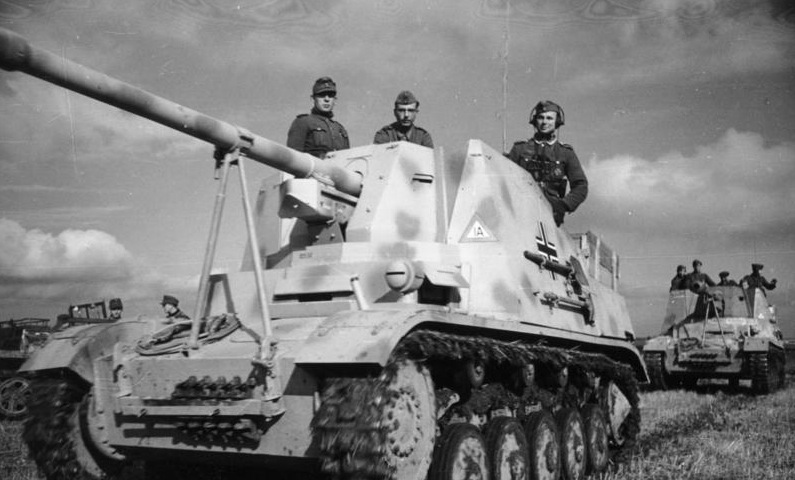
When attacking a partially armored vehicle, resolve a Specific Collateral attack through an unarmored Target Facing per D5.311. This does not change if the actual attack struck an armored Aspect.1 When combined with D5.311, any Collateral Attack (Specific or General) attacking through an unarmored Target Facing is resolved per D5.311. Such attacks will not Stun the Crew. The Crew instead would Break for failing a Morale Check and can suffer KIA and Casualty Reduction. It is also important to note that Collateral Attacks occur BEFORE any Immobilization Task Check.2 See this previous article for more information on Collateral Attacks.
Unarmored Target Facing or Aspect
Now we come to the heart of the subject. D1.2 lists an exception to an AFV’s Small Arms immunity. When attacked through an unarmored Target Facing/Aspect, Small Arms CAN affect an AFV. In such circumstances, treat the AFV as an unarmored vehicle and attack it on the ★ Vehicle line of the IFT.
Recall, there is a difference between Target Facing and Aspect. An Aspect is determined only as a part of a To Hit DR. Did it strike the Turret/upper-superstructure or Hull? The combination of knowing which Aspect (turret or hull) and Target Facing allows us to identify the AF of the target. Small Arms do not roll To Hit. They attack everything in the Location. As such, they are only concerned with Target Facing. If the Line of Fire (LOF) crosses an unarmored Target Facing, the AFV is vulnerable to Small Arms fire. With turreted vehicles, it is possible for the turret, or the hull, or both to present an unarmored Target Facing. With non-turreted vehicles, it is possible for the upper-superstructure, or the Hull, or both to present an unarmored Target Facing.
Refining Our Understanding
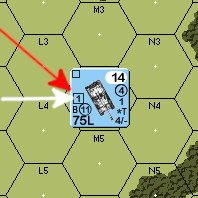
It is important to note that we still use the principle of attacking the least favorable AF from the attacker’s perspective (D3.2). Refer to figure 3. If the LOF is exactly along a hexside, we use the AF least favorable for the attacker. Thus, the white arrow attacks the AFV’s side Target Facing. The red arrow attacks the AFV’s rear Target Facing. If there is armor in all Aspects of a specified Target Facing, the AFV is immune to Small Arms attacks. In figure 3, the red arrow attacks a partially armored Target Facing (i.e., armored hull and unarmored upper-superstructure indicated by the ★ T).
If you find this confusing, perhaps some examples will help to clear everything up. First, we will discuss Infantry-based/IFT attacks and then Ordnance-based attacks.
Infantry-based/IFT Examples
Small Arms Attacks
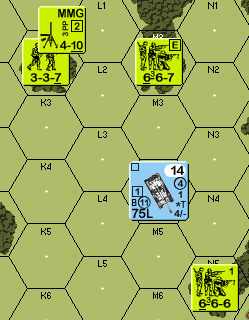
Refer to figure 4. If you need to refresh your memory on Target Facing, refer to figures 2 and 3. The American 6-6-6 squad attacks the Marder. Its LOF attacks a Target Facing having armor in both the hull and upper-superstructure Aspects. Therefore, its attack is against an armored vehicle. Small Arms cannot harm an armored vehicle but it can affect Vulnerable PRC. Since the Marder is CE by default, that 6-6-6 conducts a 6 +2 General Collateral IFT attack against the crew.
The 6-6-7 is attacking the Marder through its rear Target Facing.34 The hull is armored, but the upper-superstructure is unarmored (note the ★ T). Since the upper-superstructure is unarmored, the 6-6-7’s LOF attacks an unarmored Target Facing. Resolve this attack against the AFV in accordance with A7.308.
Resolving The Attack
Refer to the AFV Destruction Table (see this article for more details). An Original DR ≤ 3 Eliminates the AFV as a Burning Wreck. On an Original DR 4 or 5, Eliminates the AFV with a chance for Crew Survival. If the Crew Survives, no Collateral attack results (D5.6). An Original DR 6 results in Immobilization (A7.308). Before the Crew takes its Immobilization Task Check (D5.5) it must first take 2MC (Original 4) or a 1MC (Original 5). If broken, there is no additional DRM for the TC although the broken side Morale of the unit applies for the TC. An Original DR 7 is an NMC, again breaking and not Stunning. An Original DR 8 subjects the Crew to a PTC (A7.82), while an original DR ≥ 9 is No Effect.
If the MMG opts to attack on the IFT, resolve it on the ★ Vehicle line of the IFT along the 4 column. It is otherwise just like the 6-6-7’s attack and resolved in the same manner. Note that the MG cannot fire as Ordnance in this instance (A9.61). Its only option is to attack on the ★ Vehicle Line.
Residual Fire Power Attacks
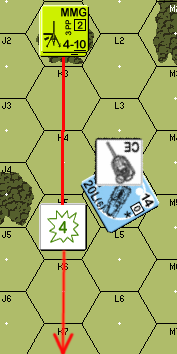
Refer to Figure 5. The red Arrow represents a Fire Lane placed by the MMG in K2. The Flak ht moves to K5. Upon entering the Location, the Residual Fire Power (RFP) attacks the AFV but how, and in which order? Per A8.22, existing Residual Fire Power always attacks first. A Fire Lane is a form of RFP but it is not a Residual Firepower counter, so it attacks second. The CE crew would take a 4 +2 General Collateral attack. This is not an attack against an unarmored vehicle since the AFV is partially armored and there is no “directionality” to an RFP attack.
Next, the MG Fire Lane attacks. This attack has a “directionality”. It is possible to determine Target Facing. Even though the turret front is armored and facing the MMG, the hull is unarmored. As such, this is an unarmored Target Facing per D1.2, and the Fire Lane attacks the AFV on the IFT ★ Vehicle line. The attack on the AFV is on the 2 column of the IFT since this is the Fire Lane’s attack. Resolve this just like the 6-6-7 squad and MMG attacks we discussed earlier in figure 4, including the chance of the Crew breaking.
Demo Charges And Flame
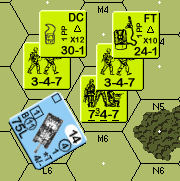
Refer to figure 6 and footnote 55. The 3-4-7 with the Demo Charge attacks the Marder. The LOF is again against an unarmored Target Aspect. Like normal, the attacker must predesignate the AFV as the target (A23.5) and the half squad must make a PAATC (A23.3) to Place the DC. Assume the unit passes the PAATC and the half squad Places the DC through the hull rear against an unarmored target. Per C7.346, the unit must make a special DC Position DR. The DRM are -1 hull rear, -2 Open Topped AFV, +1 target is CE for a -2. Assume the Final Position DR is ≤ 8.
Regardless of whether the DC is “Optimally” (Final DR ≤ 5) or “Successfully” (Final DR 6-8) positioned, the DC attacks the AFV using the IFT ★ line on the 30 column, not the C7.34 HE & Flame To Kill Table. An Original IFT DR 12 is a Dud for No effect. An Original DR ≤ 11 but ≥ 7 Eliminates the AFV with a chance for Crew Survival, while an Original DR ≤ 6 Eliminates the AFV as a Burning Wreck. This attack does not affect any other enemy units in the Location.
Had the Final DC Position DR been 9-11 (i.e., “Poorly Positioned”), there would be no attack against the AFV, but the DC would attack any Vulnerable PRC as a Specific Collateral Attack with no CE DRM. If the Final Position DR was ≥ 12 (“No Effect”), there would be no attack against the AFV or its Vulnerable PRC, but the DC would attack all other unarmored units in the same Location as Area Fire.
Thrown DC
The 3-4-7 could Throw the DC in a Friendly Fire Phase rather than placing it. This attack would incur the usual +2/+3 DRM against the AFV and the thrower’s Location. Again, you make the DC Position DR and resolve the attack against the AFV. Again, the DC affects no other units in the AFV’s Location unless the Final Position DR is 9-11 (Vulnerable PRC) or ≥ 12 (other unarmored units). Even though the AFV is the specified target, the DC potentially affects all units in the thrower’s Location.
Flamethrower
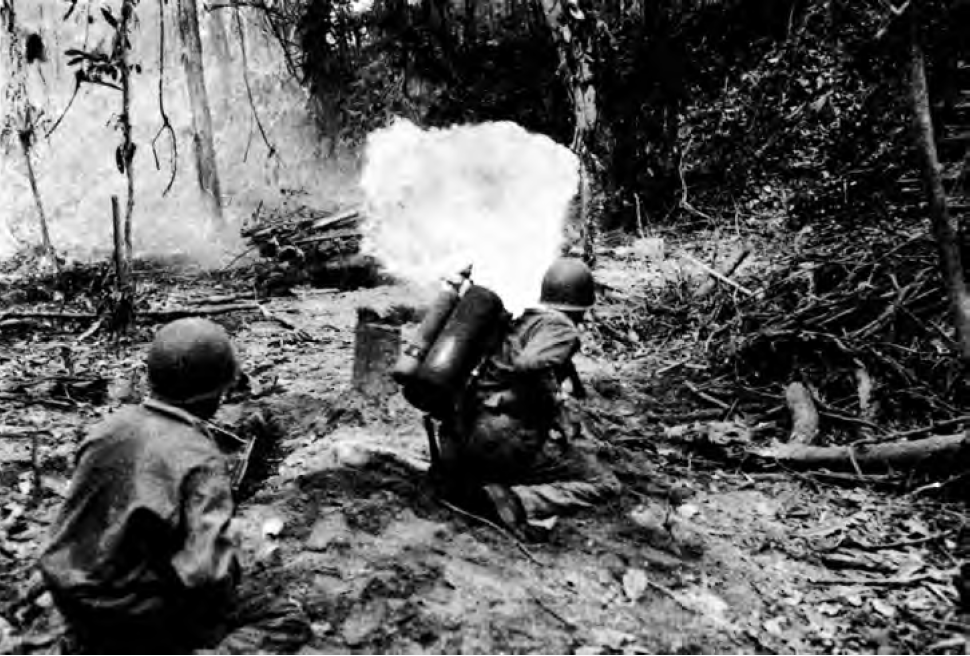
The 3-4-7 with the Flamethrower (FT) attacks the AFV. Again, the unit must predesignate the AFV, and this attack is through an unarmored Target Facing, but resolving this is also complicated. There is no TH DR with a FT but, by Q&A, the TK DR counts as the Hit Location DR.16 If hit in the armored Aspect, the Final TK# is an 9 on the C7.34 HE & Flame To Kill Table. Eliminate the AFV as a Burning Wreck on an Original DR ≤ 8. An Original DR = 9 Eliminates the AFV with a chance for Crew Survival. The Crew is not further subject to attack if it successfully makes Crew Survival DR. If the attack does not Eliminate the AFV, the Crew are subject to a Specific Collateral Attack on the 24 column in accordance with D5.311.
If the TK DR hits an unarmored Aspect, resolve the attack instead on the IFT ★ Vehicle line on the 24 column. If the attack does not Eliminate the AFV, attack the crew per D5.311. For instance, imagine the TK DR was a 5,6. This hits the unarmored upper-superstructure. An Original 11 on the 24 column equals the Vehicle ★ number. This Immobilizes the AFV. Since the attack did not Eliminate the AFV, the Crew must now take a 1MC before it takes its Immobilization Task Check. If it fails this 1MC, the Crew breaks. The broken Crew would now use its broken morale to take the Immobilization TC. Of course, the FT has rolled its X number so remove it from play.
Molotov Cocktail
Now assume that an SSR gives the American 7-4-7 squad Molotov (MOL) capability. Per the Index, Inherent FP and Inherent SW count as Small Arms. However, there is an existing Q&A suggesting something else. Per the Q&A, the TK DR also counts for determining the Hit Location (C3.9) 7. Perry also clarified this as part of my Q&A.1
The 7-4-7 designates the AFV as its target and successfully makes a MOL Check dr. The attack has a combined 18 FP on the IFT. Resolve the attack against the AFV by rolling a TK DR on the MOL column of the HE And Flame To Kill Table. This TK DR also counts as a Hit Location DR (C3.9). If the attack does not Eliminate the AFV, apply a 16 FP Collateral attack on the IFT against the vulnerable PRC.
Resolving A Molotov Attack
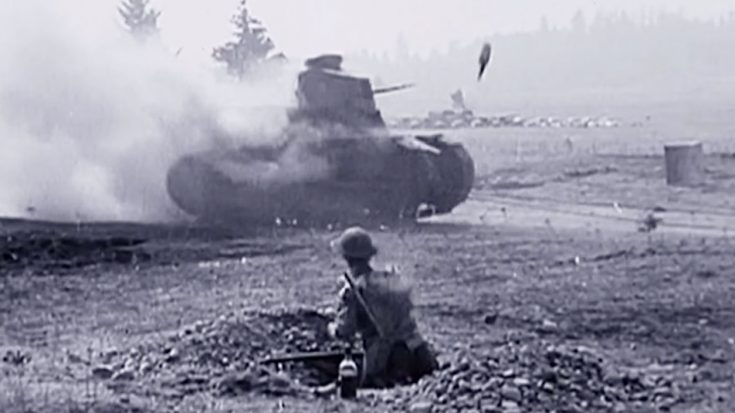
Imagine a hull hit on the AFV. The MOL TK# is a 6 with a +2 Modified for attacking an Open Topped AFV, and a +1 for rear Target Facing. Eliminate the AFV as a Burning Wreck on a Final TK DR ≤ 8 with no chance of Crew Survival. A Final TK DR = 9 Eliminates the AFV with a chance for Crew Survival. If the attack does not Eliminate the vehicle, attack the Crew with 16 FP per D5.311. Remember, this is an attack against an unarmored Target Facing even though the attack struck an armored Aspect.
Imagine an upper-superstructure hit on the AFV. The MOL TK is unchanged, but it is not relevant. This attack is against an unarmored target and resolved on the Vehicle ★ line of the IFT with 16 FP. Eliminate the AFV as a Burning Wreck with no chance of Crew Survival on an Original IFT DR ≤ 4. An Original DR ≤ 8 Eliminates the AFV with a chance for Crew Survival. An Original DR = 9 Immobilizes the AFV. The Crew would first take a 1MC and then face an Immobilization Task Check. Collateral attacks continue to apply out to an Original DR ≤11. Again, resolve the Special Collateral Attack per D5.311.
Elevation Advantage And Air Bursts
A brief reminder before delving into Ordnance-based attacks. An Open Topped AFV receiving no, or reduced CE DRM because of an elevation advantage or Air Burst is attacked as if unarmored. If the shot originates from a Location with a differential height greater than the range (e.g. fire from a Level 2 Location at Range ≤ 1) then that shot has a reduced CE DRM and triggers A7.308 and D5.311. Similarly, an Open Topped AFV using Vehicular Bypass of a Woods Location is subject to Air Bursts. Such an attack also triggers A7.308 and D5.311. Use A7.308 to resolve an attack against a vehicle attacked in these situations. A Crew, even if Buttoned Up, is also Vulnerable (D5.311). If the attack does not Eliminate the AFV, the Crew is subject to breaking, not stunning. See this article and this article for examples of this.
Ordnance-Based Examples
Area Target Type
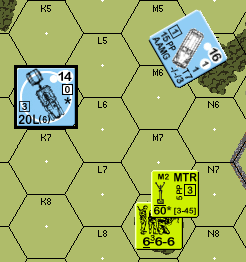
Refer to figure 7. The American mortar attacks the Flak ht in K6 using Area Target Type (ATT). Assume the attack hits. Resolve this attack per C1.55. Per C1.55 an AFV’s vulnerability does not increase because it is partially armored. As such, conduct this attack in the IFT 4 column. Per C1.55, the attack receives a -1 DRM because all the Armor Factors are ≤ 4. Referring to the AFV Destruction table, an Original ≤ 4 DR Shocks/Immobilizes the AFV based on the Hit Location of the TH DR. No Collateral Attack applies since the Crew is BU even though the AFV is partially armored.
Now the mortar turns its attention to the SPW251 ht in bypass of the woods in N5. Assume a hit. Normally, we expect to resolve this via C1.55 but recall, an Open Topped AFV attacked via Air Bursts is vulnerable to A7.308 and D5.311. The mortar attacks the AFV on the 4 column of the IFT via the ★ Vehicle Line. An Original 5 Immobilizes. An Original DR of 3 or 4 Eliminates the AFV with a chance for Crew Survival. A DR 2 Eliminates the AFV as a Burning Wreck with no chance of Crew Survival.
If the attack does not Eliminate the AFV, attack the PRC Collaterally even if Buttoned Up. They receive a -1 Air Burst DRM and a +2 CE DRM. The Crew take a NMC on an Original DR 5 and a PTC on an Original DR 6. If the Crew fails the NMC, it breaks rather than stuns.
Infantry Target Type
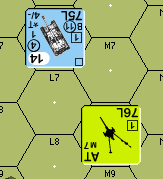
Refer to figure 8. The American Gun fires at the AFV using Infantry Target Type (ITT). Per C3.32, All AFV in the Target Location are immune to hits using ITT. The Vulnerable PRC is not immune, however. Assume the 76L fires ITT at the AFV in L6. It needs an Original TH DR 9 or less (-1 DRM for Point Blank). The AFV is unaffected even though attacked via an unarmored Target Facing. A 12 FP General Collateral Attack applies to the Crew. If the Crew fails any resulting Morale Check, it will BU and stun rather than break. [Author’s Note: This example is included for completeness. I cannot think of a time when an ITT-based attack would be more beneficial than a VTT-based attack.]
Vehicular Target Type
Refer again to figure 8. This time the Gun fires using the Vehicular Target Type (VTT). If a hit, the Hit Location (C3.9) determines how we resolve this attack. If the attack hits the hull, resolve the attack normally. Only if the attack does not Eliminate the AFV is the Crew attacked with a General Collateral Attack on the 2 FP column. This Collateral Attack will never happen in this example since any DR low enough to hurt the CE crew would also eliminate the AFV.

If the attack hits the AFV’s upper-superstructure, the attack is against an unarmored vehicle. To resolve this attack, refer to the Unarmored Target line of the C7.31 AP To Kill Table. For a 76mm Gun, the AP TK# versus an unarmored vehicle is a 9. Since this is a rear Target Facing, the Modified TK# is a 10. An Original DR ≤ 5 Eliminates the AFV as a Burning Wreck with no chance of Crew Survival. An Original DR of 6 through 9 Eliminates the AFV with a chance for Crew Survival. Finally, an Original DR of 10 Immobilizes/Shocks the AFV depending on Hit Location. Normally, a General Collateral Attack applies but again, any attack that could affect the crew would eliminate the AFV so it is safe to ignore it.
If instead, a player attacks the AFV using VTT with HE instead, resolve everything as above but using the HE TK# from the C7.34 HE And Flame To Hill Table. Nothing else changes apart from this different TK#.
Special Thanks
Thanks to Perry and his cabal of ASL rules gurus who respond to Q&A. Their quick response made this article possible. They also anticipated a few bits I most likely would have asked in a follow up too. They really came through and I appreciate it.
I would also like to thank Mark Thompson and Klas Malmström for proofreading this article through a couple of iterations. The article would not be nearly as good without each of their help. So thank them too if you have a chance.
Conclusion

This has been a long article. When I was engaged in the original conversation, I was not aware just how complex this can actually be to resolve. While it was very clear in my head how to resolve this, it was nowhere near as clear as I thought it was. The Q&A make this much cleaner. I hope you enjoyed the article and maybe learned a little from it. Until next time. – jim
A: Yes, although for DC it is the Position DR.
Q: When a MOL/DC/FT attacks a partially armored AFV through an unarmored Target Facing, does the Target Aspect hit determine if the attack against the AFV is against an armored or unarmored vehicle?
A: Yes; if hit in an armored Aspect, the attack against the AFV is treated like any other armored vehicle. If hit in an unarmored Aspect, the AFV is attacked in accordance with A7.308.
Q: Assume the target is partially armored and survives the original attack against it, how is the Special Collateral Attack against the Crew resolved? Does the answer change if the hit location is an armored Aspect?
A: The attack is against an unarmored Target Facing and resolved per D5.311; No.
A. The collateral attack occurs first.
A: Yes.
Q: Or , would the Crew only be affected using the +2 CE modifier?
A: No.
A: Yes. Q: Would it be the same if only the upper Aspect is unarmored?
A: Yes.
A. No; Position DR made but then attacked on IFT.
Q: Is the same true if the AFV is unarmored only in the turret?
A. Yes. Q: If placing the DC through an unarmored facing, must the AFV still be predesignated (A23.5)?
A. Yes.
Q: C7.346 says, If placed through an unarmored target facing, make an IFT (rather than a To Kill) DR vs the vehicle as if it were unarmored (A7.308). Is the same true if the DC is thrown rather than placed?
A. Yes.
Q: When a thrown/placed DC Position DR vs an enemy AFV is < 12, are all other enemy units in the AFV hex (aside from the AFV and its PRC) immune to the blast of the DC?
A. Yes.
Q: When a thrown DC Position DR is < 12, are the units in the thrower’s location still attacked by the DC blast (with the usual +3/+4 DRM), (assuming of course no malfunction)?
A. Yes.
A. Yes, use the TK DR.
A. TK DR serves as TH DR for Target Facing. Rules do need correcting in this regard.


Thx so much. Great article as always!
Now I’m confused. What is the effect of a “break” result on an AFV, and how do you materialize it in game?
Great article otherwise, as usual. Minor nitpick: in Figure 2, the line between “rear” and “side” really should be white instead of red, since the “worst for the Attacker” will always be the Side facing instead of Rear. (Not sure if there are cases where the “worst for the Attacker” will be the Front instead of Side; it’s certainly not the more common case)
You place a broken crew in the AFV. In the RtPh it must rout like normal Infantry using its full MF to leave the vehicle and is placed beneath the vehicle. It routs normally going forward.
I will look at the language for that other part. The point is, as the attacker, the side providing the most benefit to the defender is selected.
Wow, I don’t think I’ve ever seen this broken crew in an AFV thing. Must have been playing it wrong all this time (or partially armored vehicles are rare enough), and I’m not the only one. But there it is right in D5.311.
To make this clear in my mind: this is special for attacks through an unarmored facing/aspect, right?
I have rarely seen it. Usually when an OT AFV bypasses a woods hex. I have also seen it when a unit in a 2nd level Location fired at an AFV at range 1 (reduced CE TEM) and a 1st Level unit firing at a bypassing half track (again, reduced CE TEM).
WRT to your question: yes. This only happens when shooting through an unarmored Target Facing/Aspect. Such an attack triggers D5.311.
Very interesting. Now the problem is .. how to remember all of this 🙂
For figure 4 are you sure the MG can’t fire as ordnance? My reading of A9.61 is that the MG can fire as ordnance and that the TH roll will determine if the attack is conducted as a TK or on the * line of the IFT.
The word “hit” in A9.61 is somewhat unfortunate in my opinion. I believe the intent is attacked rather that hit. Why would a player first try a To Hit DR to get an attack on the * line when he could opt to just directly attack on the * line without need for a To Hit DR? It probably wouldn’t hurt to ask a clarifying question but the direct attack on the * IFT line is pretty clear.
Very insightful Jim. I had no idea just how little I knew about attacking partially armored vehicles. Thx!
Wow! A lot to think about! Thank you!
But, what happens if you overrun an partially armoured AFV? It would be great to have the answer in the same post.
I think the FT attack forgot the DRMs, but not sure
I can see an OVR being “directionless” and thus NA against a partially armored AFV. I think this is the most likely answer. I cannot say for sure. I can also see it depending on the Target Facing the OVR AFV entered the target’s hex across. It isn’t likely to happen very often so I don’t feel too compelled to seek an answer.
Very interesting, especially considering the button up results and the possibility of immobilization on the partially armored target. I think that for the Marder IIIh in the example, this is solid proof that reality can not be used to justify rules in ASL. From what is available on the internet (somebody has one of these actually running!), that vehicle has a fully armored hull and the driver and radio operator, engine, fuel, transmission etc are all armored as per the PzKpfw 38(t). It’s only the gun and gun grew that are (half) exposed out the back. Even the ammo is in the hull. Reality would say that instead of an immobilization result (not possible) you should have a gun malfunction result on the IFT for that type of AFV.
Destroying an AFV with Small Arms fire doesn’t happen as often as it should. It therefore bears repeating that destroying an AFV by targeting its unarmored aspect with fire on the IFT is an underused tactic that more players should become familiar with.
I have surprised at least one local player with this tactic. He was particularly dismayed to find that his crew, although BU, was nevertheless vulnerable to even Small Arms traced through his Marder’s rear target facing. His was doubled annoyed when I told him that his broken crew had to rout beneath the vehicle in the RtPh, as per D5.311. Your comment above suggests that routing is optional. Did I misinterpret D5.311?
D5.311 UNPROTECTED CREWS: The Inherent crew (as well as each Passenger) of a vehicle receiving fire (including Fire Lane Residual FP) [EXC: Sniper attack] through an unarmored Target Facing/Aspect (C3.9; including any OT AFV receiving either Air Bursts or fire from a higher elevation whose elevation advantage is > the range [5.31])—and, vs mines, the PRC of any AFV with a hull AF of 0 [B28.43]) is Vulnerable even if BU, and receives no (or a reduced; 5.31) CE DRM. Consequently the crew is not susceptible to Stun/Recall from such an attack; it is instead subject to PTC/MC/K/KIA results. If it breaks it must rout from the vehicle using normal Infantry rout procedures [EXC: it expends all its initial-RtPh MF to be placed beneath the vehicle].
Finally a minor point re the SdKfz 10/5 VASL counter used at the beginning of your article. You rightly drew attention to the white interior of the Marder, which indicates, as per D1.23, that the AFV is Open-Topped or OT. The SdKfz 10/5 halftrack beside it should also have a white interior. This is a VASL error, as the physical counter in Valor of the Guards, for example, is correct. Similar halftracks, such as the SdKfz 10/4, SdKfz 6/2, and SdKfz 7/1, are unarmored and therefore do not have a white interior, which is where I think the VASL error stems from.
D1.23 OPEN-TOPPED (OT): An AFV whose entire overhead depiction is printed on a white background is an OT AFV.
You have the example for the FT attack of DR 4,6 but then said a roll of 11 on the 24 star line only immobilizes the vehicle. Is that a typo or am I missing something? Thanks great article.
Great article! I finally got around to reading it, I posted the original question mentioned in your article. Good to read what was there plus more. Thanks again.